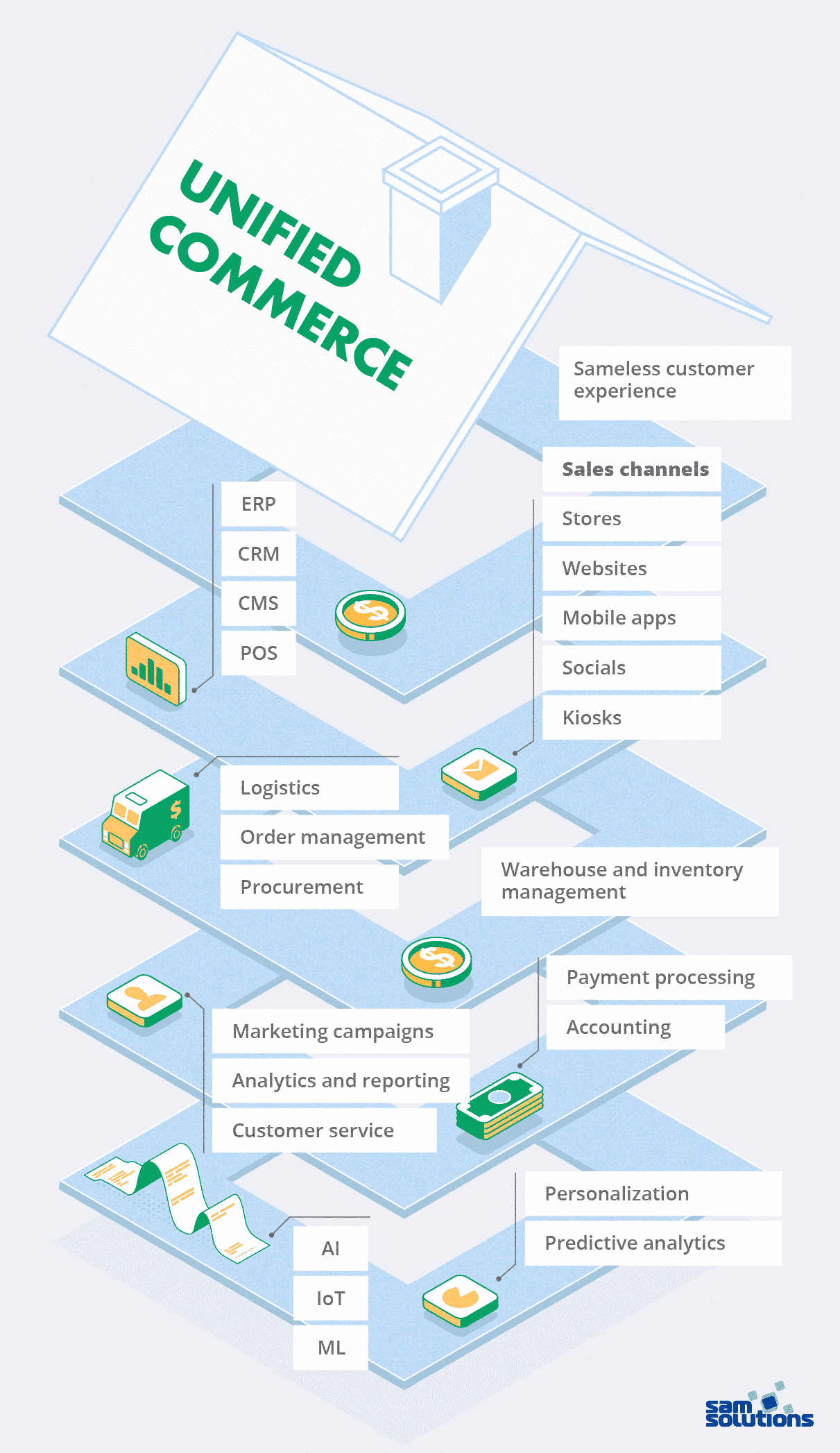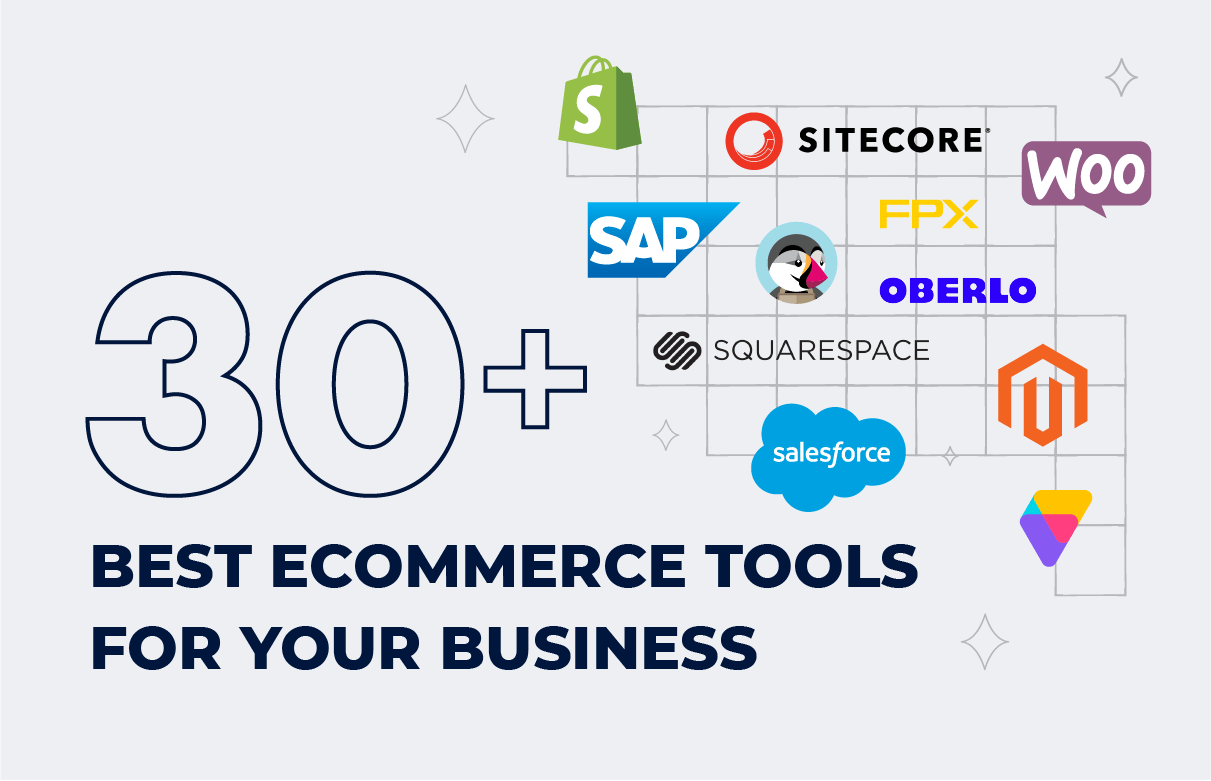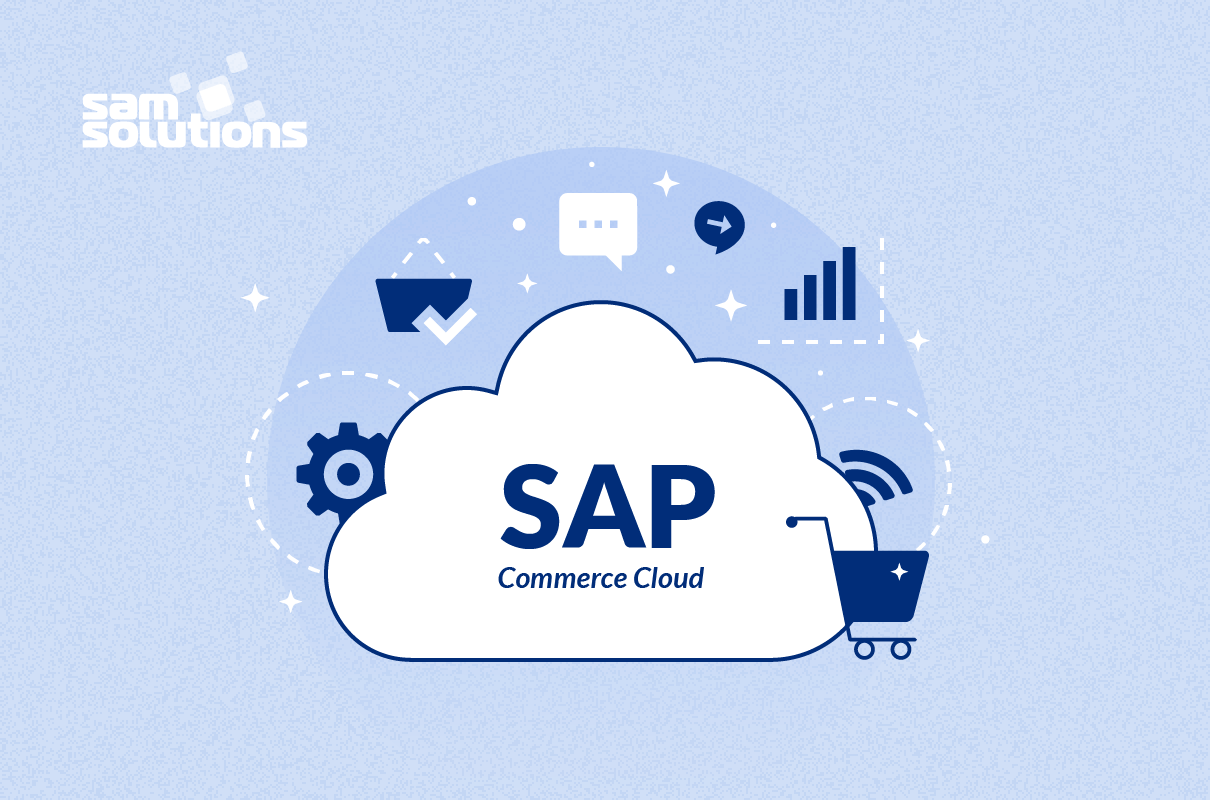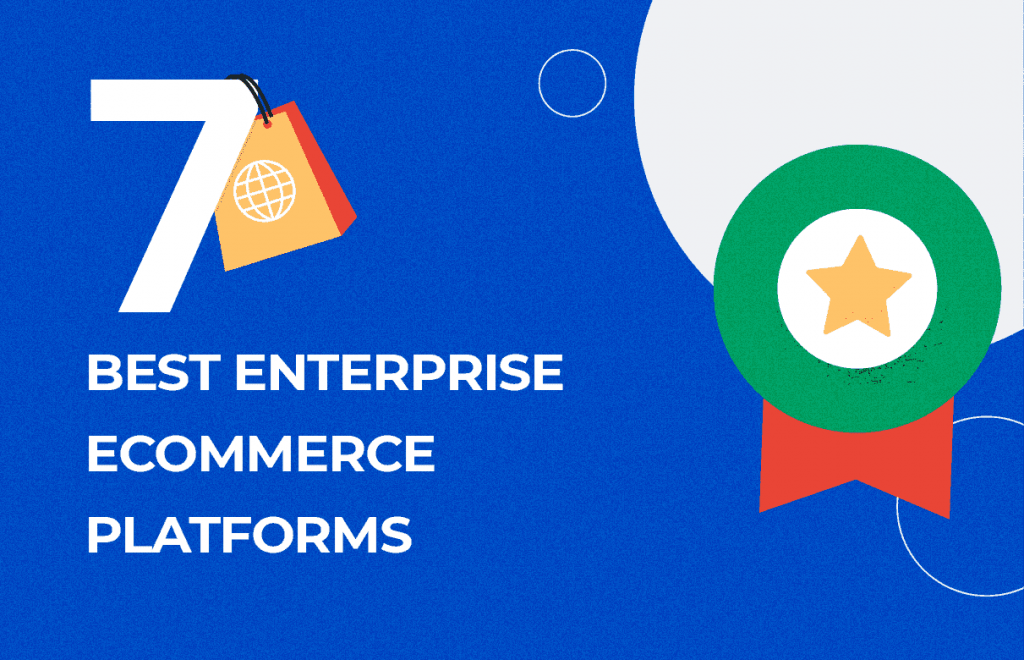For the last two decades, we’ve been witnessing the evolution of the retail industry from separate offline stores to distributed ecosystems comprising numerous sales channels.
Today, retailers must provide an omnichannel customer experience and deliver personalization across all channels to be successful. They implement technologies such as the Internet of Things or ML and software solutions such as POS or CRM systems to run their business more efficiently. But it’s a challenging task to make various apps, solutions and systems interact seamlessly with each other.
The time has come for companies to use only one commerce platform to control all their sales apps and systems, collect data and extract valuable insights. This process is called unified commerce and it is likely to soon become the main facilitator for retail businesses.
SaM Solutions offers a wide range of platform-based and from-scratch ecommerce development services that help you reach your digital sales objectives.
Unified Commerce Explained
Previously, the commerce industry was based on isolated sales channels. Currently, most retailers utilize what’s known as an omnichannel commerce model. However, this model can’t solve all the inconsistencies that can plague a shopping journey. That’s why the demand for the unified commerce approach is gaining traction.
Unified commerce is a comprehensive software system that enables retailers to:
- monitor the function of the entire business
- see customer and product information from all touchpoints in real time
- analyze data and convert it into valuable insights
- make the right decisions based on relevant data
- deliver a personalized customer experience.
Simply put, you get one platform that integrates product data, customer profiles and back-office retail management functions.
Unified commerce is like a house made of blocks: each block is crucial for the entire system, and all the blocks function as a whole.

Just imagine how many blocks you can integrate under one roof:
- Sales channels (stores, websites, mobile apps, socials, kiosks)
- ERP (enterprise resource planning), CMS (content management systems), CRM (customer relationship management), POS (point of sale) systems
- Order management
- Logistics
- Procurement
- Warehouse and inventory management
- Payment processing
- Accounting
- Marketing campaigns
- Customer service
- Analytics and reporting
This kind of approach helps companies get rid of isolated apps and eliminate silos between departments.
A unified commerce platform is based on smart technologies. Using machine learning, artificial intelligence, the Internet of Things and predictive analytics, business owners can access accurate and relevant data at any time and even make predictions for future events.
In actual fact, the demand for unified commerce has increased as a consequence of the COVID-19 pandemic, which has highlighted the importance of customer experience and the flexible digital journey.

Unified Commerce Is Beyond Omnichannel
The omnichannel commerce approach seemed like an improved version of multichannel commerce — the method of selling goods via several uncoupled physical and digital touchpoints. Omnichannel integrated separate entities into a coherent system and arranged the process of data exchange between them.
However, omnichannel could not complete the puzzle, and some retail business functions still required manual operation, which has led to inefficiencies and time lags.
The idea of unified commerce appeared as a result of industry recognition for the need for further development and improvement.
Unified commerce differs from the omnichannel model by the level of integration and consistency it provides.
Moreover, due to the wider incorporation of artificial intelligence and predictive analytics, the unified commerce model can eliminate all possible gaps and keep information continuously updated and shared. This means that your clients and employees will avoid the frustration of the product they ordered being out of stock, for example.
You can easily attract a loyal audience and retain customers if they have no negative shopping association with your brand, and this is the main task for all commerce businesses.
The Main Aspects of Unified Commerce
What are the pillars of unified commerce? There are four main categories: sales channels, customer interaction, software systems and product data. Let’s take a look at how these key components operate in a unified platform.
Sales Channels
Customers usually reach out to your brand via several channels, so you need to ensure that you offer an equally seamless experience and relevant data across your touchpoints. Whether browsing or buying in store or online, all buyers should have access to the same opportunities: the look and feel, usability, navigation, promotions, special deals and everything else must be the same everywhere. This is what we call consistency across all channels.
Customer Interaction
Again, because users interact with your business at different times and via different devices, they should have a chance to continue making purchases via another channel from the point at which they paused. For example, if a buyer were searching for some product on your website and added some items into the cart, this should be reflected in your app as well.
When you keep records of customer behavior across channels (e.g. purchase and search history) and synchronize all their actions in a unified manner, you can easily create personalized offers and deliver only relevant recommendations. This makes customers happier and consequently, your sales go up.
Software Systems
The very concept of unified commerce implies the integration of numerous software systems performing specific business functions. ERP, CRM, POS, CMS, mobile apps and other software solutions for retailers should be fully integrated and work as one to deliver impeccable services.
Product Data
The information concerning products or services you offer must always be accurate and relevant across all your sales channels. Your customers and employees must be given access to identical product descriptions, characteristics, prices and availability to avoid misunderstandings. Product information must be consistent at all levels of the buying journey.
Advantages of Unified Commerce
The modern commerce world is concentrated on customer-centricity: your client’s needs and desires are a concern above all others. The beauty of the unified commerce approach is that it provides the right tools for making your business customer-centric.

The following are the four reasons why your clients will get a seamless shopping experience with your unified commerce platform.
- Flexibility. Buyers can start, continue and finish purchases using various devices and sales channels, without barriers or interruptions. Their buying journey is more flexible than ever.
- Interaction tracking. Fully integrated channels make it possible to monitor every engagement your customers have with your brand, and to analyze these for further decision-making.
- Real-time updates. Fully integrated channels make it possible to instantly update product information at all levels of the system, so your buyers always get relevant data.
- Personalized recommendations. The monitoring of customer interactions allows you to create tailored offerings for each client.
How Your Retail Business Can Benefit from Unified Commerce
The advantages of unified commerce for shoppers are self-evident. Now, let’s look at this concept from the business point of view.
- Automation. A centralized digital platform enables retailers to automate most of the time-consuming manual processes, which results in improved employee productivity.
- Efficient management. Since the unified commerce platform lifts barriers at all business levels, ensuring the transparency of processes, it facilitates the most efficient management possible. Retail staff are aware of any changes in real time, so they can make the right decisions concerning inventory, delivery, marketing and other business processes without delays. You can get rid of such common retail problems as overstocking and understocking.
- Reduced errors. Automation and business transparency ensure data is more accurate than ever and significantly reduce the number of errors associated with manual management of separate solutions. Moreover, predictive analytics based on AI and ML algorithms helps you anticipate and prevent issues, resulting in reduced costs. How fantastic is that?
- Increased sales. The benefits mentioned above contribute to the primary purpose of unified commerce — seamless customer experience. So, if you provide impeccable services, you can easily retain clients and attract new ones. Happy clients mean consistently high sales.
SAP Can Get You Acquainted with Unified Commerce Experiences
How do you choose the technical foundation for a unified commerce platform? You should look for a robust and scalable cloud platform that will be able to integrate all of your business solutions and make all processes run like clockwork.
At SaM Solutions, we have extensive experience developing commerce projects based on SAP C/4HANA (ex. SAP Hybris). We recommend SAP products as the basis for your unified commerce strategy. And here are some arguments:
- First of all, SAP Customer Experience (CX) Suite brings together everything you need for commerce, sales, marketing, customer service and data protection.
- The ERP suite SAP S/4HANA is the most powerful solution for the running of your back-office processes.
- SAP products can be available via the SAP Cloud Platform.
- They can seamlessly integrate with third-party systems.
- SAP leverages intelligent technologies (AI, ML, Big Data, predictive analytics).
As you can see, SAP provides you with the maximum possible services for creating a fully integrated digital retail ecosystem and delivering consistent experiences.
Full Integration to Delight Your Customers
The consolidation and integration of processes and software solutions are the most efficient way of doing business.
The retail industry’s future seems to be tightly connected with unified commerce platforms. Why is it the best strategy? Because the modern shopping experience is distributed across devices and locations. According to statistics, 60% of buyers start their shopping on one device or location and finish on another one.
When you connect all your touchpoints, you continuously keep control of your workflow, eliminating the disconnect between eCommerce and offline sales. More importantly, you can keep in touch with your shoppers regardless of the time and location.
To sum up, unified commerce is about supporting the balance between employees, customers, products and data via a single platform.



























 5 Reasons Why Your Business Needs a Mobile eCommerce Application
5 Reasons Why Your Business Needs a Mobile eCommerce Application Using Salesforce to Improve Your Sales Pipeline: Five Tips
Using Salesforce to Improve Your Sales Pipeline: Five Tips Cross-Platform Mobile Development: Five Best Frameworks
Cross-Platform Mobile Development: Five Best Frameworks How to Develop Custom Accounting Software
How to Develop Custom Accounting Software 10 Best Web Development Frameworks in 2024
10 Best Web Development Frameworks in 2024




![What Is Ecommerce Customer Service? [Including 8 Best Practices]](https://www.sam-solutions.com/blog/wp-content/uploads/Customer-Service-in-eCommerce.png)







 Top 30 Ecommerce Tools to Elevate Your Business in 2024
Top 30 Ecommerce Tools to Elevate Your Business in 2024 5 Best Tools to Improve Embedded Software Testing
5 Best Tools to Improve Embedded Software Testing Why React and Node.js Are the Top Technologies for Creating High-Performance Web Apps in 2024
Why React and Node.js Are the Top Technologies for Creating High-Performance Web Apps in 2024 10 Best IoT Platforms for 2024
10 Best IoT Platforms for 2024
Now is the time to consider a single centralized platform instead of distributed apps for all of your sales operations. This is the only way to bring your business to new heights. The unified commerce concept appeals to me. Thanks for a detailed explanation.
Well, unified commerce is a great tool for synchronizing sales touchpoints and backend operations. Such an approach sounds reasonable, but I think the price would be relatively high. On the other hand, the unified platform should pay off quickly.
Your article is very informative and pleasant to read, thank you. I guess many retailers will decide in favor of unified commerce quite soon because they must provide excellent shopping experiences to stand out of the crowd.
I believe that unified commerce will become the mainstream in a couple of years because customers dictate the conditions for further development of e-commerce and retail businesses.
Thanks for this useful content. We live in a world where customer experience is the main differentiator for retail companies. The concept of unified commerce seems to be the right direction.